|
March 19, 2023
Dear Neighbors and Friends,
I hope that you and your loved ones are doing well, staying healthy, and looking out for your neighbors and friends during this past week.
In tonight’s newsletter you’ll find information about the big legislative deadline that just passed on Friday. You’ll also hear about the big priority, consensus bills that are headed to the Governor’s desk for her signature. These have to do with Housing/Homelessness and potential investments in the semiconductor industry. Though I don’t have time to write about it in detail, I’ll say here that the House is starting to move forward on some of the non-consensus bills that are priorities for the session—those dealing with Oregon’s affirmation of reproductive rights and transgender rights following the Supreme Court’s Dobbs decision and with further steps to improve firearms safety. These are priorities for Democrats but also focuses of Republican opposition. I’ll say more about those next week.
On the COVID front, last week saw continuing improvements in case numbers, positivity rates, and hospitalizations last week. There was an increase in ICU hospitalizations for COVID. We’ll see next week if that continues or is an anomaly. All Oregon counties providing adequate data (two did not) are now showing Low Risk on the CDC website. Wastewater analysis results remain stable, though slightly more cities show increases than decreases.
The March COVID forecast report from OHSU is out, and you can find details in tonight’s newsletter. The forecast for COVID remains very positive. RSV, the highly infectious respiratory illness found mainly in children is now nearly non-existent, and hospitalizations for the flu are nearly non-existent. Good news overall.
In the links section you’ll find links to more articles triggered by this being the third anniversary of the start of the pandemic, with a number of interesting reflections and analyses. You’ll also find the latest findings on Long COVID.
Until next week, please do your best to stay happy, healthy and safe. And let me know if you have any questions or thoughts about anything in this week’s newsletter.
Another Deadline Has Passed
I know it’s a recurrent theme of this newsletter, but I must say once again that the Legislative session is a series of deadlines, deadlines related to bill requests, to bill drafting, to bill introductions, to committee scheduling, to committee votes, and then it starts all over again in the opposite chamber. With each deadline, the number of concepts under consideration becomes smaller and smaller.
Friday was a critical one.
If a bill was not scheduled and posted on the legislative website for a hearing and a “work session” (i.e., a committee vote) by the end of Friday, it cannot move forward this session. If you’re wondering about the status of a bill that’s important to you, go to olis.oregonlegislature.gov and look it up under “bills.” I'm happy to report that nearly all of my priority bills are still progressing.
As you can imagine, last week was extremely stressful for legislators and their staffs, making last-minute pushes for bills that hopefully had a chance, but sadly often didn’t. It was equally stressful for committee chairs (and committee staff), who were the objects of those pushes.
It’s always hard to say no, and I as a committee chair tried to accommodate as many of my colleagues as possible, at least to give their bills a hearing. That’s a real challenge when (as is the case for Senate Education) we have triple the number of bills assigned to our committee than the schedule can accommodate.
Before you lose all hope on a bill that you care about, check to see that there isn’t a counterpart bill in the other chamber. Advocates like to pursue identical bills in both chambers “just in case.” Those bills will rarely move forward at this point. (If they do, there’s probably been some miscommunication.)
As Chair, I try to work with my Vice-Chair (who’s always from the opposite party) to try to schedule bills that are real priorities for her caucus. Sometimes they’re bills that will not be able to get a majority vote coming out of caucus, but with the right amendment perhaps they can, and we work together on getting it to a point where I and my Democratic colleagues can vote for it. That doesn’t always work out, but it’s worth giving it a shot.
And then often they’re bills that have good concepts and addressing important issues, but they’re just not ready to move forward—too much opposition, too many unanswered questions. Those will often become the subject of work groups during the interim, in an effort to get them ready for the short session or the next long one.
What you definitely do NOT want to see happen is a bill dropping off accidentally, just because someone left it off a list that it was supposed to be on. Sadly, it happens. At this point, I don’t think it’s happened to any of my personal bills or bills assigned to the Education Committee. If so, I’m sure I’ll hear about it tomorrow at the Capitol . . .
The NEXT deadline—and this is a particularly big one—is April 4th. By the end of April 4th any bill (among those that were posted on Friday) that is not voted out of committee is gone for this year. Now, that doesn’t necessarily mean that they’re slated for a floor vote: many bills are creating programs that will cost money, and they’ll be sent to Ways and Means (where they’ll sit for the next two months). Others may be sent to the Rules or Revenue committees, which do not follow the same deadlines.
If you have any questions about the fate, or likely fate, of a bill that’s particularly important to you, please send us an email, and we’ll see what we can find out.
Housing, Semiconductor Bills Move Forward
I reported last week on the twin Housing bills that are priorities of Governor Kotek, and that had just passed from Ways and Means. They went on to pass the House on Wednesday, on strong bipartisan votes. HB 2001, the policy bill, passed on a 50-9 vote. HB 5019, the budget bill, passed on a 49-10 vote.
As I mentioned last week, we in the Senate can expect many hours of bill-reading this week, since HB 2001 is 75 pages long. We have scheduled a special floor session on Tuesday evening in order to get through it. It should take around four hours. We had hoped that the Republicans would waive the bill-reading requirement for this very popular bill, but at this point that doesn’t seem to be in the cards.
We also saw movement on another of the Governor’s priorities, SB 4, the bill seeking to make land and resources quickly available for new large semiconductor manufacturing facilities, in hopes of obtaining significant federal support through the CHIPS Act. It passed out of the Joint Committee on Semiconductors on Wednesday on a 12-2 vote. It is expected to come before (and pass out of) the Joint Committee on Ways and Means on Friday.
In its original form, the bill proactively moved a piece of Washington County from a farm-use category that precludes it from being used for industrial purposes and would have made it immediately available for development. In the version that was amended on Wednesday, it allows the Governor to select promising parcels for potential development, and allows for public input and a brief appeals process.
The CHIPS Act itself includes a number of what I believe to be important, progressive sideboards around workforce standards and environmental impacts for any project that it funds. These will apply to the programs that we’re enabling here in Oregon.
I expect to be an aye vote in Ways and Means and on the floor.
Coming Up: Ways and Means Travels the State
During each long session, as the budget for the next two years is being developed, legislators who are members of the Joint Committee on Ways and Means participate in town halls in locations around the state. They always come after the Co-Chairs of Ways and Means release their initial budget, which builds off of the Governor's Recommended Budget that we received at the beginning of February. The Co-Chairs' budget should be out this week or the very beginning of next week.
These hearings are a chance for Oregonians in those locations to come before the committee and provide two minutes of public testimony on their budget priorities without having to travel to Salem. It’s perhaps less critical this year, since we now are taking remote testimony from people all over the state, but it’s still a significant and exciting ritual. Committee members often also take the opportunity to visit interesting local projects while they’re visiting the different locations.
We’ve just received the schedule for this year’s hearings. Here they are:
Saturday, April 8 (10:00am - 12:00pm) - Portland
- Location: Portland Community College - PAC Auditorium, Sylvania Campus
- 12000 SW 49th Ave, Portland, OR 97219
Friday, April 14 (5:00 - 7:00pm) - Newport
- Location: Newport Performing Arts Center
- 777 W Olive St, Newport, OR 97365
Friday, April 21 (5:00 - 7:00pm) - Roseburg
- Location: Umpqua Community College
- 1140 Umpqua College Rd, Roseburg, OR 9747
Friday, April 28 (5:00 - 7:00pm) - Ontario
- Location: Four Rivers Cultural Center
- 676 SW 5th Ave, Ontario, OR 97914
- Note: Ontario, Oregon is in the Mountain Time Zone
These four in-person hearings will be followed by a zoom hearing open to everyone in the state sometime during the first week of May.
ON THE COVID FRONT
Weekly Data Report:
OHA now updates and reports COVID metrics once a week, on Wednesdays. Here are the most recent set of weekly results, for this past week from 3/9/23 through 3/15/23.
This week’s report shows generally ongoing improvements in COVID metrics here in Oregon.
- The 7-day average for newly reported infections went down a little again last week, from 305 to 289 reported infections per day this last week. The number of new cases is likely an undercount, as many people are using home tests to determine their infection status but are not reporting those results.
- Average test positivity also went down quite a bit last week, from 9.4% to 8.0%. The number probably skews high because it likely reflects a higher proportion of people showing COVID symptoms (and thus reporting or going in for a test, rather than self-testing and never reporting).
- On Wednesday there were 222 COVID hospitalizations, down a little from the previous week’s 229 COVID-19-related hospitalizations statewide. It appears that the number of COVID hospitalizations peaked earlier, and at a lower level, than had been forecast in the most recent OHSU report from 2 weeks ago. Hospitalizations are now our best indicator of disease spread. Again, however, most of these hospitalizations are not in and of themselves due to COVID—most are those who tested positive after having been admitted for other reasons.
- The number of COVID patients in Oregon’s ICUs on Wednesday rose last week, from 18 to 28 statewide. These are the most serious COVID infections.
- There were 54 COVID-19-related deaths reported during the last week, down from the previous week’s 12. However, it’s important to remember that many of every week’s reported deaths actually occurred in earlier weeks but were just reported to the state, and others that likely occurred have yet to be reported. The newsletter’s final graph shows when the deaths actually occurred, and you’ll see that the number of COVID deaths each day continues to remain relatively low.
Weekly County Report: All Counties Reporting at Low Risk
The CDC assigns risk levels based on a combination of the number of new COVID cases and the number of people in hospital for COVID.
According to the CDC Daily Counter (updated each Thursday), all of Oregon’s counties are at Low Risk, except for two (Klamath and Lake in Southern Oregon), who are not showing anything (presumably a problem with their reporting data).
We can also track the cases, deaths, and test positivity rates for each county at this website.
Positivity rates for the three Portland-area counties were all down a lot last week. Clackamas County in now at 6.5% (way down from 12% the previous week). Multnomah County has dropped to 5.4% (down from 6.3%). Washington County has also gone down to, 7.0% (down from 9.1%).
Remember that these are all based on reported test results, and so are more likely to be a little higher than the total percent positivity (i.e., if one were to include all tests taken).
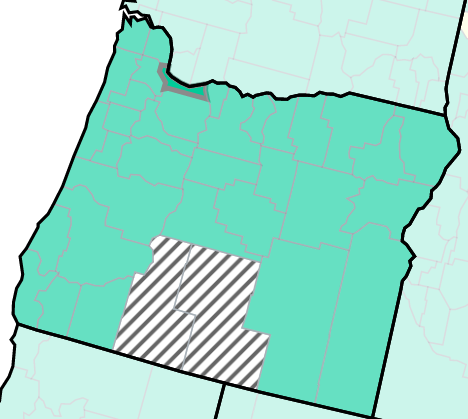 
This Week’s Wastewater Monitoring Report: Slightly More Increases
With testing reports giving us just a fraction of infections out there, wastewater monitoring has become a more reliable indicator of the amount of virus in cities around the state. That report is updated each week.
This week’s report, updated on Wednesday, showed slightly more increases than decreases after a week of declines. Sixteen percent of cities showed increases or sustained increases last week, while 13% showed declines or sustained declines. The remaining 71% showed no change.
Gold Beach and Medford showed sustained increases last week.
OHSU Report Shows Declines Across the Board
Another OHSU Forecast Report was released on Thursday, March 16. It is now being called the “OHSU Oregon Hospital Forecast and Trends: COVID, Flu, RSV.” It now comes out once a month.
It uses data provided by OHA and others that project how fast the viruses may spread in the population and provides projections on possible outcomes, including infection rates and impacts on hospital capacity. The lead author is Dr. Peter Graven, Director of OHSU’s Office of Advanced Analytics.
This week’s report—the first in nearly a month—shows overall stability in the disease metrics, with small COVID increases and ongoing declines in flu and RSV. The primary forecast has been revised upwards to include the effects of XBB.1.5. This current trend of small COVID increases should peak in two weeks.
Here are some details:
- The number of people with COVID -19 in Oregon peaked at 261 on Feb. 23 and dropped to 222 as of March 14.
- The XBB.1.5 strain of COVID has increased to nearly 90% of infections across the region in recent estimates.
- The number of people waiting in Oregon emergency rooms for beds, and the number of available hospital beds, are back to where they were before the winter surge in illnesses.
- Flu and RSV cases are expected to remain low. RSV has returned to nearly negligible levels in Oregon. Flu hospitalization levels have dropped to near zero.
- COVID-19 levels in wastewater in Oregon peaked the week ending March 1. While infections levels in the water reached similar levels to those observed during the winter surge, the impact on hospitalizations remained mild.
- The rate of people going to Oregon emergency rooms for COVID peaked at 3.2% the week of Feb. 12. It's dropped since then to 2.2%.
- The percentage of positive COVID tests in Oregon peaked at 10% the week of Feb. 12. It's dropped since then to 8.6%.
- There were 2 children with COVID in Oregon hospitals as of March 13 (down from 5 last month).
- Since the last forecast, the XBB.1.5 strain of COVID-19 has produced a mild wave of infections. This wave seems to have peaked and is declining slowly.
- The COVID forecast shows continuing declines, without a specific variant putting people at new risk.
- The Type B strain of flu is still not common in the U.S. But France and some other countries are seeing a mild wave of Type B flu. It's not clear whether this could happen in the U.S. The current forecast assumes it won't.
- The number of COVID deaths is expected to remain low.

Corrected Link to Rockefeller U “Super-Dodger” Study
Last week’s newsletter included a link in the OHA Q&A section to a study at Rockefeller University, where researchers are accepting applications for participants (remotely or in person) who have never tested positive for COVID-19. Unfortunately, the link was broken and OHA has now repaired it. Click here for the correct link.
COVID Q & A from OHA (from OHA weekly newsletter)
Dr. Melissa Sutton, OHA medical director of respiratory viral pathogens, answered this week’s questions.
Q: My husband was ill and tested positive for COVID-19. I became ill five days later but tested negative. I took the test two more times while ill but still tested negative with the same test my husband took. I had no nasal discharge with my version of the illness. Is it possible I had it but just didn’t test positive? Another time that I was sick, and my doctor said my symptoms were COVID-19, I also tested negative. What's going on? – Marbra, Portland
A: “I know it’s frustrating – to be exposed to COVID-19, become sick and then repeatedly test negative for the virus. In your situation, it’s safe (and wise) to assume that you likely had COVID-19 on both occasions despite the negative test results, and to then take precautions not to spread the virus to others. Generally speaking, when you take a rapid at-home COVID-19 test, positive results are accurate, and negative test results are less accurate. One reason for this is that at-home COVID-19 tests detect virus particles in your nasal passages. If the virus isn’t being shed in your nasal passages, for example, the test won’t pick it up. For more on false negative test results, check out our blog.”
Q: Why can't we self-report home test results? Though numbers look low, people who test positive at home are not part of those numbers. Current practice of not including these numbers keeps Oregon data falsely low. – Walter, Damascus
A: “Numbers of new COVID-19 cases have been increasingly inaccurate over time, in particular since self-testing became widespread following the Omicron surge. OHA looks at other indicators of community transmission—specifically test percent positivity and wastewater trends—to understand COVID-19 activity in Oregon. Because COVID-19 has become an incredibly common infection, and because state resources are limited, reporting of self-test results is no longer available.”
Additional COVID Updates and Links


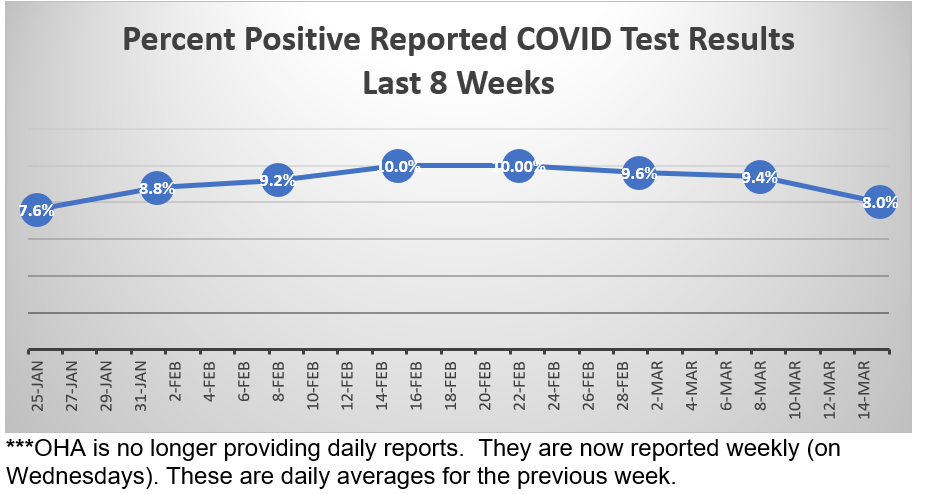
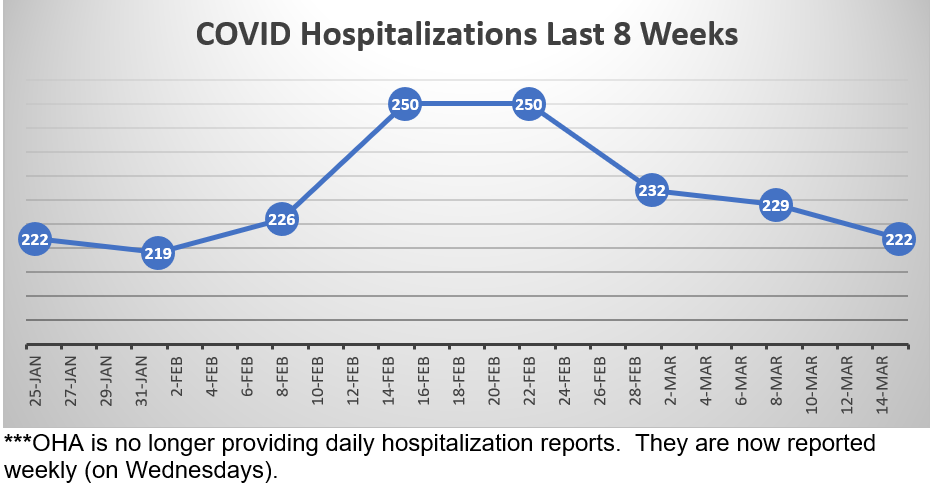
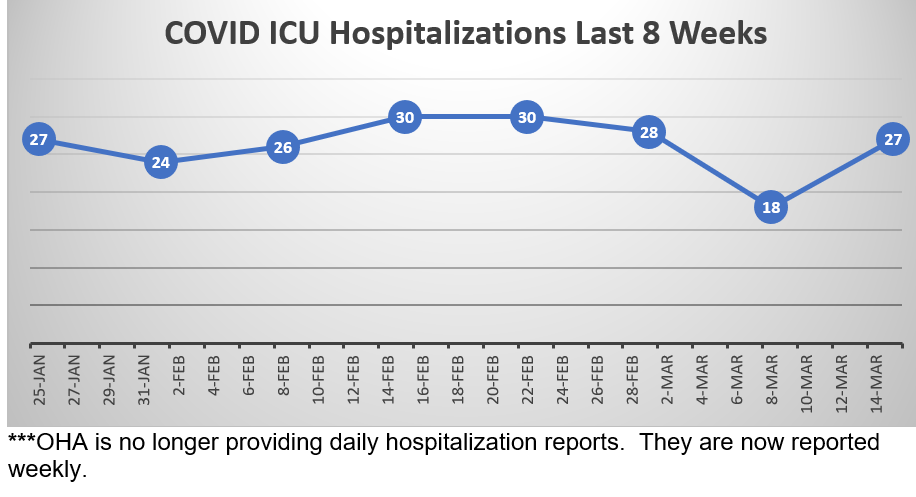

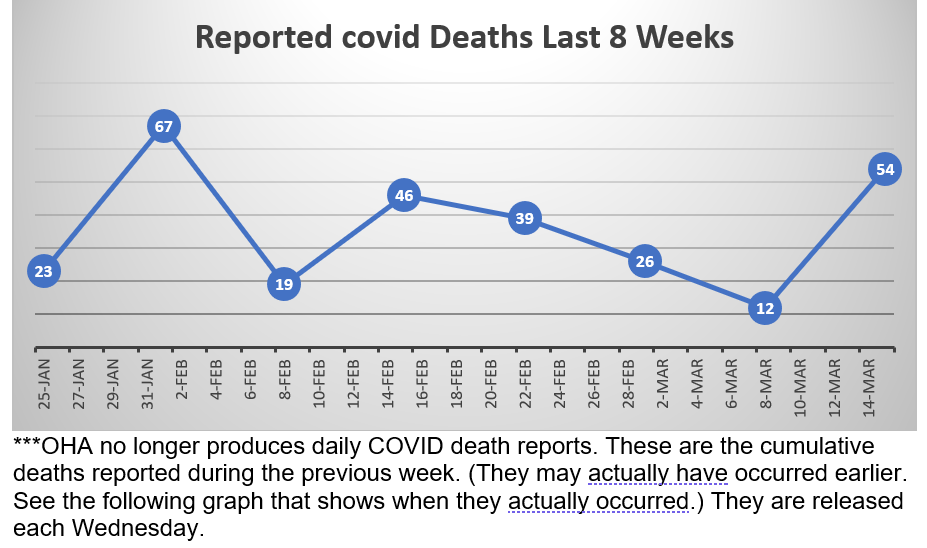

Here again are some COVID resources that you will find useful:
If the above links are not providing you with answers to your questions or directing you to the help that you need, please consider me and my office to be a resource. We’ll do our best to assist you or steer you in the right direction.
All the best,
 Senator Michael Dembrow
District 23
email: Sen.MichaelDembrow@oregonlegislature.gov
web: www.senatordembrow.com
mail: 900 Court St NE, S-407, Salem, OR, 97301
|